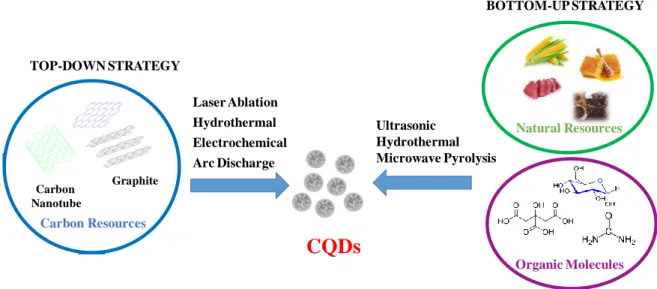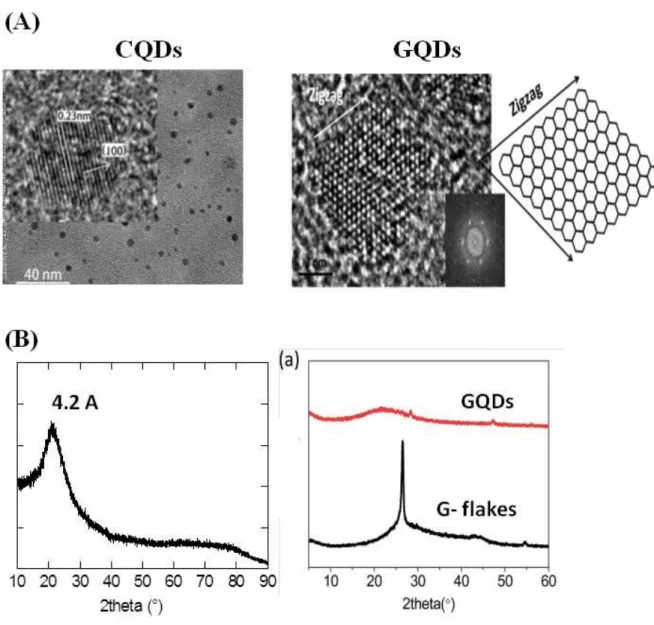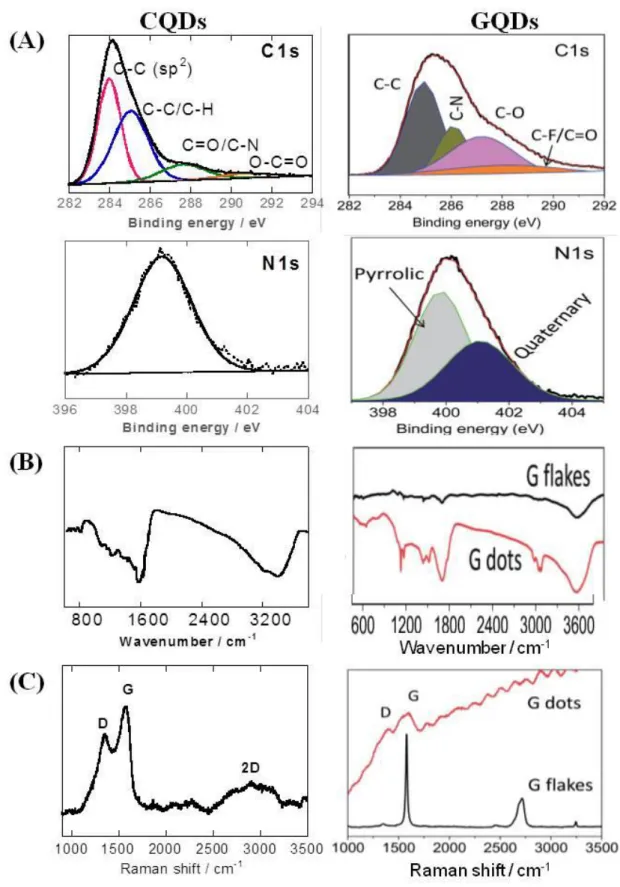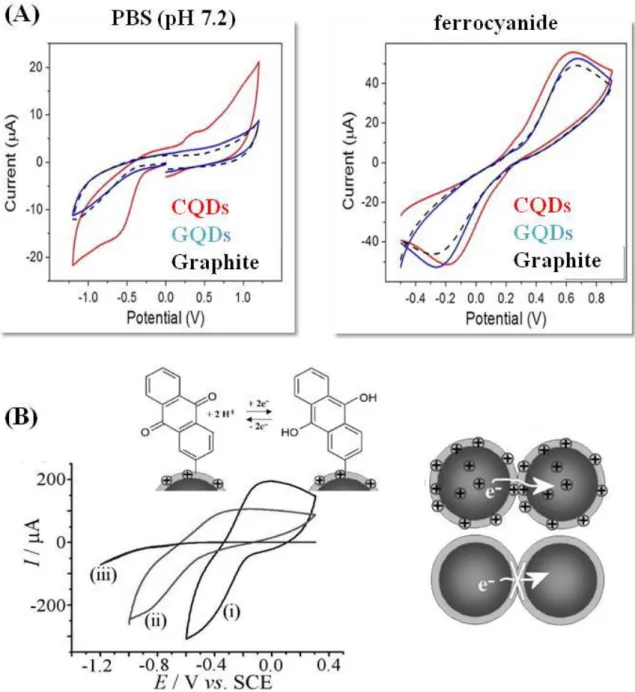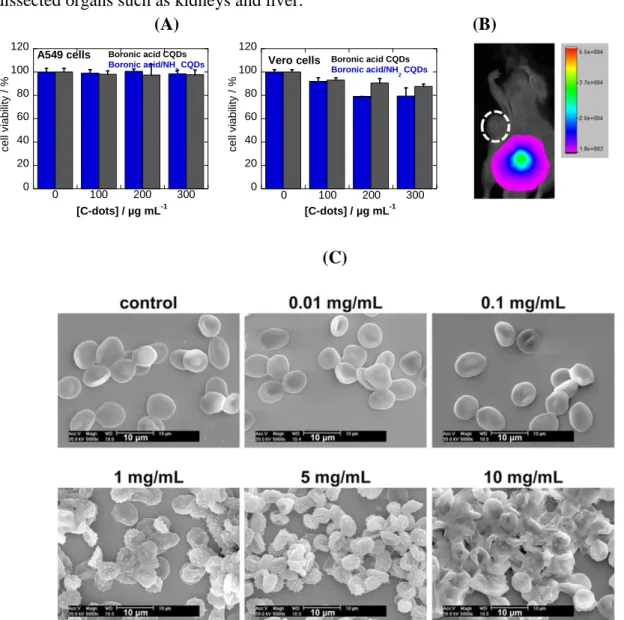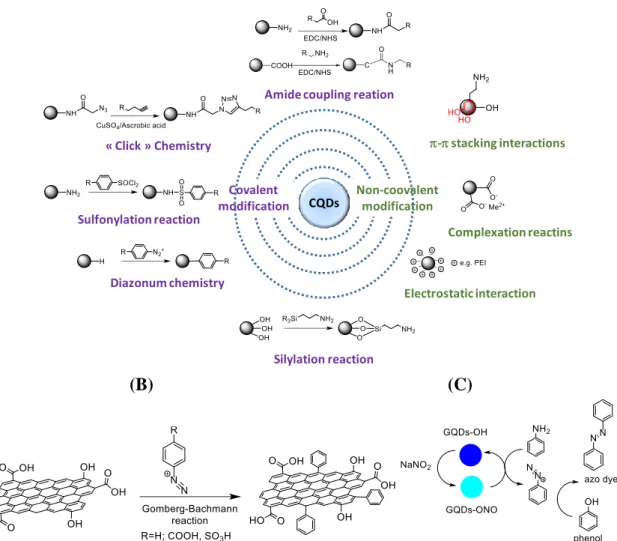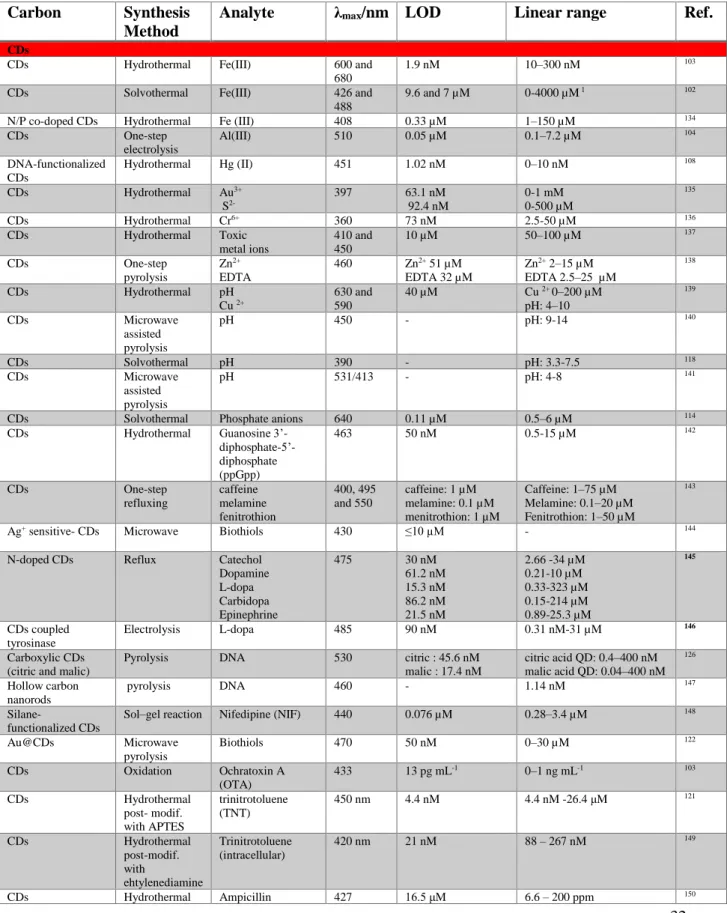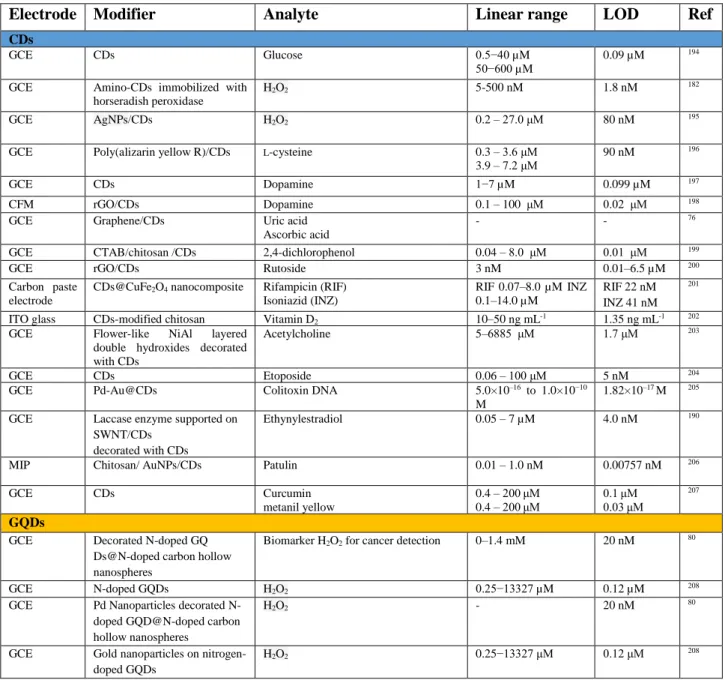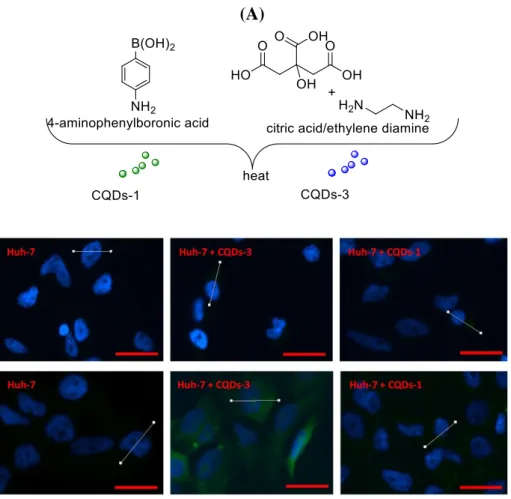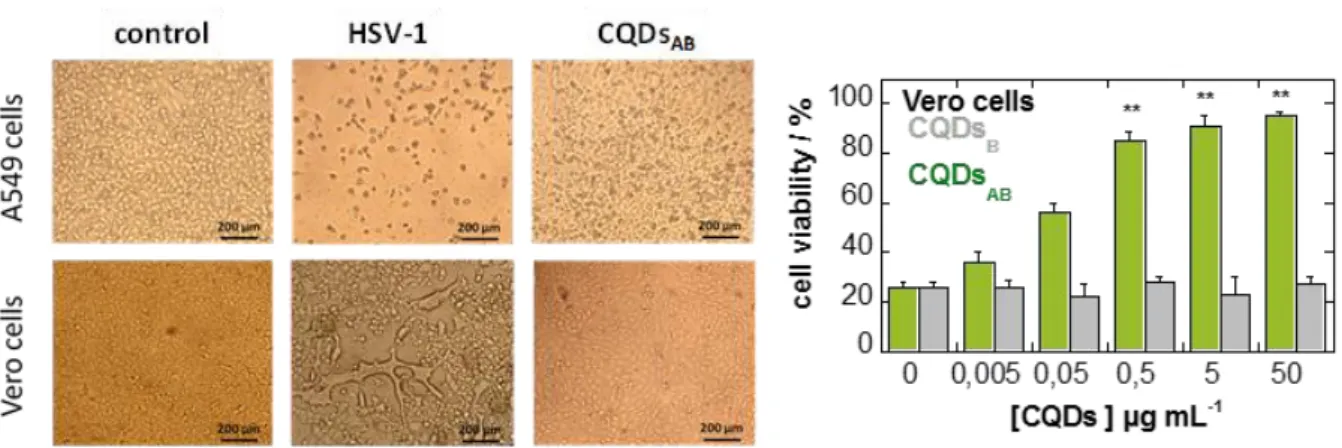HAL Id: hal-02390129
https://hal.archives-ouvertes.fr/hal-02390129
Submitted on 2 Dec 2019
HAL is a multi-disciplinary open access
archive for the deposit and dissemination of sci-entific research documents, whether they are pub-lished or not. The documents may come from teaching and research institutions in France or abroad, or from public or private research centers.
L’archive ouverte pluridisciplinaire HAL, est destinée au dépôt et à la diffusion de documents scientifiques de niveau recherche, publiés ou non, émanant des établissements d’enseignement et de recherche français ou étrangers, des laboratoires publics ou privés.
Carbon-based quantum particles: an electroanalytical
and biomedical perspective
Khadijeh Nekoueian, Mandana Amiri, Mika Sillanpää, Frank Marken, Rabah
Boukherroub, Sabine Szunerits
To cite this version:
Khadijeh Nekoueian, Mandana Amiri, Mika Sillanpää, Frank Marken, Rabah Boukherroub, et al.. Carbon-based quantum particles: an electroanalytical and biomedical perspective. Chemical Society Reviews, Royal Society of Chemistry, 2019, 48 (15), pp.4281-4316. �10.1039/C8CS00445E�. �hal-02390129�
Carbon-Based Quantum Particles:
An Electroanalytical and Biomedical Perspective
Khadijeh Nekoueian,1,2 Mandana Amiri,1* Mika Sillanpää,2 Frank Marken,3 RabahBoukherroub,4 Sabine Szunerits4*
1 Department of Chemistry, University of Mohaghegh Ardabili, Ardabil, Iran
2 Laboratory of Green Chemistry, School of Engineering Science, Lappeenranta University of
Technology, Sammonkatu 12, FI-50130 Mikkeli, Finland
3 Department of Chemistry, University of Bath, Bath BA2 7AY, United Kingdom
4 Univ. Lille, CNRS, Centrale Lille, ISEN, Univ. Valenciennes, UMR 8520-IEMN, F-59000
Lille, France
To be submitted to Chemical Society Reviews
Abstract
Carbon-based quantum particles, especially spherical carbon quantum dots (CQDs) and nanosheets like graphene quantum dots (GQDs), are an emerging class of quantum dots with unique properties owing to their quantum confinement effect. Many reviews appeared recently in the literature highlightening their optical properties, structures, and applications. These papers cover a broad spectrum of carbon-based nanoparticles excluding a more detailed discussion about some important aspects related to the definition of carbon-based particles and the correlation of optical and electrochemical aspects in relation to sensing and biomedical applications. A large part of this review is devoted to these aspects. It aims in particular to act as a bridge between optical and electrochemical aspects of carbon-based quantum particles, both of which are associated with the electronic nature of carbon-based quantum particles. A special focus will be on their use in electroanalysis notably their benefits in redox and electrochemical analysis with emphases on their applicants as sensors. Electroanalysis is an easy and cost-effective means to give qualitatively and quantitatively information of a specific analyte in solution in a time scale of some minutes. The integration of carbon-based quantum particles into these detection schemes as well as their incorporation into composite nanomaterials has large improved detection limits with possibilities for their integration of for point-of-care devices up to personalized medicine. This review will emphasis on some of these aspects but will also include nanomedical aspects of carbon-based quantum particles, ultimately correlated for such developments.
1 Correspondance should be send to: Mandand Amiri (mandanaamiri@uma.ac.ir), Frank Marken
3
Content
1. Introduction
2. Synthesis of carbon-based quantum particles
2.1. Top-down synthesis of carbon-based quantum particles 2.1.1. Arc discharge method
2.1.2. Laser ablation
2.1.3. Electrochemical synthesis
2.2. Bottom-up synthesis of carbon-based quantum particles 2.2.1. Chemical or thermal oxidation
2.2.2. Hydrothermal synthesis 2.2.3. Microwave synthesis 2.2.4. Supported routes
2.2.5. Large scale synthetic routs
3. Chemical and Physical Properties of carbon-based quantum particles 3.1. Chemical structure
3.2. Optical properties 3.3. Redox properties
3.4. Cell viability and toxicity
4. Surface Functionalization of carbon-based quantum particles 5. Applications
5. 1. Chemical and biological sensing 5.1.1. Photoluminescence sensors
5.1.2. Electrochemiluminescence sensors 5.1.3. Electrochemical sensors
5.2. Recent biomedical applications 5.2.1. Bioimaging
5.2.2. Drug delivery systems
5.2.3. Antibacterial and antiviral properties 5.2.4. Inhibition of protein aggregation 6. Summery and Outlook
4
1. Introduction
The interest in carbon-based quantum particles dates back to 2004, when fluorescent carbon quantum dots were accidentally formed during electrophoretic purification of single-walled carbon nanotubes.1 Carbon-based quantum particles are now part of a rapidly expanding field and many reviews appeared recently in the literature highlighting their optical properties, structures, and applications.2-16 The term “quantum particle” is used to distinguish them from the much broader field of carbon nanoparticles (CNPs), including next to carbon blacks, a large variety of carbon nanocomposites. Carbon-based quantum particle are thus regarded as electronically single domain, which relates to the exciton size (typically 1-2 nm in carbon structures), and include carbon nanostructures of less than 10 nm in diameter, noted carbon quantum particles (CQDs) and graphene nanosheets of usually less than 10 nm in later size, co-called graphene quantum dots (GQDS). Due to their unique and tunable photoluminescence, exceptional physicochemical properties, remarkable conductivity, generally low cytotoxicity and excellent water dispensability, carbon-based quantum particle emerged as universal nanomaterials widely used in optical and electroanalytical applications as well as for nonmedical applications (Figure 1). Carbon-based quantum particles are as a consequence replacing semiconductor quantum dots, which, owing to their strong and tunable fluorescence emission, have been used for years in applications where stable and strong fluorescence is required. However, their high toxicity, caused by the presence of heavy metals, restricted their safe use in clinical settings. Replacing semiconductor quantum dots with carbon-based quantum particles overcomes this limitation by providing biocompatible particles at low cost production, exhibiting chemical inertness in addition to similar fluorescent properties. Where is the place of carbon-based quantum particle in the carbon nanomaterials family?
The carbon nanomaterials family is ranging from sp3-rich nanostructures such as nanodiamond (also known as diamond nanoparticles) to sp2-rich graphene nanosheets and graphene quantum dots (GQDs). Between these extremes, one finds a large variety of carbon nanostructures with varying sp2/sp3 ratio (Figure 1). Nanodiamonds are made up of a diamond core and are with a sp2 carbon shell and/or different surface functional groups.17
Carbon nanoparticle (CNPs)18, 19 encompass a panel of nanomaterials including carbon black, amorphous carbon, carbon soot, carbon dots (C-dots) and core-shell nanocarbons, with no real scientific consensus on the term describing them. Carbon black, for example, is the generic name of carbon particles which are produced by incomplete combustion of gaseous or liquid hydrocarbons.20 Amorphous carbon, informally known as coal or carbon soot, is an allotrope of carbon without crystalline structure, consisting of a mixture of sp3 and sp2 carbon, which converts into graphite upon graphitization at high temperature. These particles are sometimes also referred to as carbon nandots with overall diameter of about 10 nm, existing often as aggregates to give particles of 20-50 nm in diameter.21
5
Figure 1: Carbon-based nanomaterials including carbon quantum particles: (a) TEM and HR-TEM images of carboxylated detonation nanodiamonds; (b) SEM image of carbon black, (c) SEM image of carbon quantum dots (CQDs); (d) TEM image of MWCNTs, (e) SEM image of C60 hollow spheres (reprint with permission from Ref.22); (f) TEM image
(HRTEM inset) of graphene quantum dots (GQDs).
So what makes a carbon nanostructure a carbon quantum particle? Is there any real difference between carbon quantum dots, graphene quantum dots, carbon dots, carbon nanoparticles, etc. definitions widely used without any real consensus in the literature?
Carbon quantum particles are a class of zero-dimensional nanomaterials that exhibit discrete quantized energy levels and different densities of states and have an obvious crystal lattice, which marks its difference to carbon nanodots.7 In contrast to other carbon nanostructures, the properties of carbon quantum particles are largely determined by quantum mechanical effects and several parameters such as band gap, band edge position and density of states, being constant in bulk carbon, become dependent on the dimensions of the carbon nanomaterials (Figure 2). Shrinking CQDs in size changes the state density from a band structure to discrete energy levels. That is the reason why carbon quantum particles are largely known under the name carbon quantum dots (CQDs). As the size of the particles decreases to molecular or atomic size, the exciton (electron-hole pair) is further confined and the energy band gap structure becomes identical to that of a molecular electronic structure.
In other words, the photoluminescence properties vary sensitively with the size of the carbon quantum particles due to dependence of the HOMO-LUMO gap on the size, with increasing size resulting in a red-shifted emission. Optical quantum confinement effects occur when the size of the nanostructure approaches the Bohr excitation radius (e.g. 1-2 nm in carbon nanotubes),23 which correlates to carbon-based quantum particles of 2-10 nm in diameter. The electronic structure of carbon quantum particles can be probably best described using a modified Jablonski diagram as shown below in Figure 2c. Upon excitation, non-radiative
6
processes dissipate energy from S1 and the emitted photon has less energy than the initial
excitation energy, resulting in a red-shifted emission compared to the excitation. The role of the defect state is as upon excitation, non-radiative processes occur which transfer energy to the defect states with some amount of energy loss. Once there, the emitted photon from the defect state is substantially red-shifted compared to the excitation energy. One direct consequence of the quantum effect is the photoluminescence character of CQDs, which is size dependent, whereas carbon nanoparticles necessitate modification of surface properties through surface passivation techniques to stabilize the optical properties and to allow tuning of photoluminescence features.7 The energy gap in the CQDs is divided into several levels with fluorescence occurring through excitation and emission within the core of the quantum dots.
Indeed, next to quantum effects, features related to surface composition become dominant upon decreasing the size of the nanostructures. More atoms are taking the role of edge and corner sites, and the effect of functional groups on the physico-chemical properties of the carbon-based are becoming more pronounced.24-27 That the emission peak position is often related to the excitation wavelength (ex) is currently believed to be a result of optical
selection of nanoparticles of different sizes (quantum effect) and/or from surface chemistry, and different emissive traps on the quantum particle surface issues. This indicates that most of the CQDs are currently non-uniform particles. However, more and more cases are emerged with an ex independent emission position due to the ability to control the size uniformity and
7
Figure 2 : Quantum confinement effects in carbon-based particles: (a) Electronic structures of bulk carbon, 10 nm and 20 nm CQDs; (b) Effect of particle size on HOMO-LUMO gap; (c) Modified Jablonski diagram to illustrate the electronic structure of CQDs; (d) Proposed energy levels of GQDs depending on size and surface function (reprint with permission of Ref.29).
8
The distinction between carbon (CQDs) and graphene quantum dots (GQDs) is limited to mainly morphology. GQDs are crystalline zero-dimensional disks of graphene in the size of 2-20 nm, while CQDs are spherical particles comprising an amorphous to monocrystalline core with predominantly graphitic (sp2 carbon) shell.7 While there is a lot of confusion in the literature, both materials are being part of the family of carbon quantum particles (Figure 1), consisting of C, H, N and O present in the form of various groups providing water solubility and surface functionalization. CQDs as well as GQDs often contain a considerable amount of carboxyl groups, which imparts the particles with excellent water dispersibility and suitable chemically reactive groups for further functionalization and surface passivation with various organic, inorganic and biological materials. These carbon-based quantum particles can also easily functionalized with heteroatoms or hybridized with different substances including metal oxides, biomolecules or conducting polymers to tailor their structural and physico-chemical properties.30 In the early time of carbon-based quantum particles, enormous effort
has been devoted to developing methods for their synthesis and surface modification. As the preparation method is fundamental to the resulting physic-chemical properties, a more detailed discussion is given in the next chapter.
2. Synthesis of carbon-based quantum particles
The diversity of carbon-based quantum particles, is linked to the large amount of synthetic methods available (Figure 3). A review by Shen et al.31 captures much of the current progress and the excitement, while the synthetic methods for the formation of GQDs have been reviewed recently in Ref.32 Here we give a global overview of methods applicable to the formation of carbon-based quantum particles without differentiation between CQDs and GQDs.
Figure 3: Synthetic approaches for carbon-based nanomaterials.
Independent of the carbon nanostructure aimed at, the synthetic approaches are generally classified into two main categories: top-down and bottom up. The top-down methods are based on breaking down larger carbon structures such as graphite powder, carbon rods, carbon
Organic Molecules Ultrasonic Hydrothermal Microwave Pyrolysis
CQDs
Laser Ablation Hydrothermal Electrochemical Arc Discharge Carbon Resources Graphite Carbon Nanotube BOTTOM-UP STRATEGY TOP-DOWN STRATEGY Natural Resources9
nanotubes, carbon black and even candle soot,33 by methods such as laser ablation,34 hydrothermal,35, 36 electrochemical oxidation,37, 38 or arc discharge.39 The advantage of the top-down approaches for the preparation of CQDs is that abundant raw materials can be used, allowing large-scale production and simple operation. The formed particles feature a high crystalline nature and excellent aqueous dispersibility. These carbon nanoparticles possess in general perfect sp2 carbon structure and often lack efficient gap to give fluorescence. The size and surface chemistry is thus modulated using oxidizing agents such as concentrated acids (HNO3, H2SO4/HNO3 mixture), where bulk carbon materials are cut into small pieces, while
the surface is modified with oxygen containing groups. This two-step route has become well accepted for the formation of GQDs based on the conversion of graphite into graphene oxide (GO) sheets using the Hummers method and the second step consists of cutting the GO into GQDs with various methods.
While the top-down strategy is based on breaking bulk carbon materials into small pieces by physical or chemical methods, the bottom-up approach uses selected molecular precursors, which upon dehydration and carbonization processes forms CQDs. The precursors possess generally –OH, -COOH, -C=O and NH2 groups which can be dehydrated at elevated
temperatures. There are countless of approaches to perform the dehydration and carbonization processes including hydrothermal,40 microwave-hydrothermal,41 plasma-hydrothermal
approaches42 etc. These methods offer exciting opportunities to control the molecular size and shape and fine tune the physico-chemical properties of CQDs as well as using green one-step synthetic approaches
In general, the bottom up approaches for the synthesis of CQDs are currently facing three issues: aggregation during carbonization, difficulties related to size control and achieving uniform properties as well as achieving suitable surface functions critical for solubility and selected applications. Post-treatments such as filtration, centrifugation, dialysis, gel electrophoresis, column chromatography are mostly required. Confined pyrolysis and electrochemical approaches are on the other hand well suited to overcome aggregation issues. 2.1. Top-down synthesis of carbon-based quantum particles
2.1.1. Arc discharge method
The arc discharge method has been widely applied for the preparation of carbon nanomaterials.43 Arc discharge is the electrical breakdown of a gas to generate a plasma. The chamber consists of two electrodes: one being the anode and filled with powdered carbon precursors, the other being the cathode usually a pure graphite rod (Figure 4A). After filling the chamber with a gas or a liquid and applying a power supply (AC or DC), the electrodes are brought into contact to generate an arc. During arc discharge, a large amount of heat is released resulting in the sublimation of the carbon precursors filled in the anode, and their drift towards the cathode where they are deposited in form of nanostructures. After oxidation of the crude materials (soot) in nitric acid, alkaline extraction and purification via gel electrophoresis, hydrophilic fluorescent CQDs are formed.33 The main drawback of this
10
approach is the co-existence of a mixture of differently sized carbon nanostructures, often difficult to separate.
2.1.2. Laser ablation
A fast way to synthesize CQDs is based on laser ablation of carbon-based materials. The potential of large scale CQDs synthesis using laser ablation is nevertheless limited as the zone of target erosion is narrow and the synthetic yields are low. There are, however, several interesting reports using laser ablation for the synthesis of CQDs. Surface passivation can be achieved by further refluxing in HNO3 for 12 h and upon post-modification with polyethylene
glycol (PEG) groups. Laser ablation of activated carbon (4% ash) in a water/ethanol solution (5:2) was shown by Yogesh et al. to from CQDs of 4 nm in size.44 A one step process based on laser irradiation of a graphite target using the second harmonic beam at 532 nm of the
Nd:YAG in H2O/ethanol or diethylenetriaminepentaacetic acid solution for the formation of 3
nm sized CQDs was reported by Tarasenka.45 The synthesized particles exhibited strong
photoluminescence in the visible region. The laser ablation of a solid carbon material in liquid
environment with laser pulses of 1064, 532 and 355 nm under different irradiation times was lately investigated.34 Wide CQDs size distribution was observed for the 1064 nm laser due to the deeper penetration of the laser light into the dielectric during the ablation process, being thus less adapted for the formation of size controlled CQDs.
2.1.3. Electrochemical synthesis
Electrochemical etching of different carbon-based electrodes is a viable low cost alternative for the formation of CQDs (Figure 4B). In this method, carbon electrodes such graphite rod electrode is electrochemically cut down into CQDs and GQDs. One of the first electrochemical synthesis of CQDs is that of Zhou et al.46 who formed CQDs during electrochemical cycling of MWCNTs in the presence of tetra-n-butylammonium ions. Oxidation of graphitic electrodes at +3.0 V was proposed by Zhao et al.28 to produce CQDs with emission wavelengths at 445 nm and 510 nm. Independently, the electrochemical preparation of carbon nanocrystals was achieved by cycling between -3.0 and +3.0 V at 0.1 Vs-1 of a carbon rod working electrode immersed in phosphate buffer solution (PBS).39 Alkali-assisted electrochemical etching allowed the preparation of CQDs with controlled size.47 Using graphite rods as anode and cathode and NaOH/EtOH as electrolyte, CQDs were formed upon the application of a current in the 10-200 mA cm-2 range. This work also underlines that an alkaline environment is one of the key factors for the synthesis of CQDs by electrochemical oxidation, as under acidic conditions no particles were formed.
Electrochemical synthesis of photo-luminescent CQDs from glycine under alkaline conditions has been recently proposed by Wang et al.38 Application of +10 V between two Pt electrodes resulted in the oxidation of glycine and led to the formation of ammonium ions that further reacted with un-oxidized glycine through an amidation reaction. The as formed ions underwent electro-polymerization, carbonization and passivation to form highly fluorescent CQDs with an average size of 2.4±0.4 nm and crystalline nature.
11
Figure 4: “Top-down” approaches for the synthesis of carbon-based quantum particles: (A) Schematic illustration of an arc discharge set up (reprint with permission from Ref.43); (B) (a) Preparation of CQDs from glycine through electro-oxidation, electro-polymerization, carbonization and passivation, (b) TEM image, (c) UV/Vis and photoluminescence spectra (reprint with permission from Ref.38).
12
2.2. Bottom-up synthesis of carbon-based quantum particles 2.2.1. Chemical or thermal oxidation
For many years, the formation of carbon-based quantum particles has been achieved by pyrolysis or incomplete combustion of hydrocarbons. Polymer precursors were mostly employed as the fuel for pyrolysis should be thermally stable and able to yield useful carbon residues following high temperature processing. The carbonization process occurs through a number of different flame methods. Incomplete combustion of hydrocarbons leads to the formation of condensed carbonaceous particles (soot) in the nanometer diameter range, called carbon blacks. Inspired by this approach, it was found that soot derived from the combustion of candles or natural gas burners represents an excellent source for CQDs. In 2007, Liu et al. collected soot by placing a piece of aluminum foil atop a burning candle, then mixing with oxidizing agents and refluxed for 12 h.48 CQDs smaller than 2 nm were collected by
centrifugation or dialysis} Chemical oxidation has several advantages including low cost, high yields of CQDs (>10%) with large-scale production possibility. However, concentrated acids and bases along with long time treatments are needed for their preparation, resulting in fluorescent particles of often low quantum yields and poor size distribution. Dong et al. have developed a facile method to extract oxidized CQDs directly from activated carbon by chemical oxidation.49 Their formation is achieved by refluxing activated carbon in
concentrated nitric acid for 24 h, followed by neutralization with NaOH and dialysis against double distilled water.56 The synthesis of water soluble and photoluminescent carbon nanostructures from almond husk, a bio-waste was recently reported by Tripathy et al.50
2.2.2. Hydrothermal synthesis
Hydrothermal carbonization is a low cost, environmentally friendly and nontoxic route to produce carbon based materials from various precursors. This method consists of sealing an organic precursor within a closed system and heating at high temperature under reduced pressure. The interest of this approach lies in the good control of the nucleation processes in an environmentally friendly manner without the use of strong acids or bases. Precursors such as chitosan,51 carbohydrates,52 and a large variety of green precursors,6 have been explored and the list is countless. 3-aminoproyltrimethoxy silane was lately considered as organic precursor to synthesize organosilane-functionalized fluorescent CQDs at 300°C in 2 h with a quantum yield of 42.6 % without the introduction of an additional passivation agent.53 Among the disadvantages of this method is the possible formation of a carbon soot during the synthesis, which can reduce the yield. Sadhanala et al.54 reported the synthesis of CQDs of 2 and 7 nm in size using sucrose as a precursor without additional surface passivating agents or acids and bases. A one-pot hydrothermal synthesis of CQDs with efficient up and down converted PL was recently proposed by Li et al. (Figure 5A).55 This method allows in addition the
13
Figure 5: “Bottom-up” approaches for the synthesis of carbon-based quantum particles: particles. (A) Hydrothermal synthesis of CQDs using citrate and PEI precursors along with TEM image of the formed particles (reprint with permission from Ref. 55); (B) Supported
synthesis of CQDs using modified silica spheres as a carrier and resol as a carbon source (reprint with permission form Ref.57).
2.2.3. Microwave synthesis
Microwave technology, that can achieve high solution temperatures in some minutes, has become a very important process in synthetic chemistry while being a simple and a cheap approach for the fast synthesis of CQDs. Using sucrose as the carbon source and diethylene glycol as reaction medium resulted in the formation of green luminescent CQDs within only one minute under microwave irradiation.58 Liu et al. developed microwave-mediated pyrolysis of citric acid with various amine molecules to synthesize highly fluorescent CQDs.59 The amine molecules, especially primary amines, play a dual function as N-doping precursor and surface passivating agents. Synthesis of CQDs using poly(ethylene glycol (PEG) as precursor under oxygen atmosphere resulted in particles with remarkable photoluminescent properties.60 To decrease the synthesis time of CQDs and obtain different sizes and properties by varying irradiation power and duration, microwave synthesis is the best option. Yang et al.
14
proposed a green and rapid microwave-assisted solid-phase synthesis (solvent-free) approach for the formation of highly fluorescence CQDs in 4 min. The particles emit in the blue with a quantum yield of up to 63.2% in water solution and display yellow fluorescence in the solid state.61 Zhu et al. described a facile and economic microwave pyrolysis approach to synthesis fluorescent CQDs with electrochemiluminescence (ECL) properties.62
2.2.4. Supported routes
Discrete CQDs with uniform size can be prepared by confined pyrolysis of an organic precursor in nanoreactors. It is based on the adsorption of the organic precursor into a porous nanoreactor via capillary forces, followed by pyrolysis of the confined precursor into carbonaceous matter, and release by removing the nanoreactor. Porous silica is the most widely used nanoreactor,57 but polymer core-shell nanoparticles can also be efficiently used. One such a route was employed by Liu who used surfactant-modified silica spheres as supports (Figure 5B).57 Carbon precursor resols were introduced to the SiO
2/F127 modified
particles. The F127 surfactant phase is key as it is served as an anchor for the adsorption of resols through hydrogen bonding so that polymerization took place on the shell of the SiO2
spheres rather than in the solution. Heating to 900°C in argon for 2 h led to CQD/SiO2
composites where the silica sphere was removed through dissolution in NaOH. 2.2.5. Large scale synthetic routs
Considering the great potential of CQDs for numerous applications, it is extremely necessary to consider large-scale synthetic routs.11 Most of the current methods and in particular hydrothermal synthesis due to its simplicity, low-coast, and high efficiency can be used to produce CQDs in the mg range regardless of the raw material used; however only a few works allow mass production, such as the carbonization of Chinese ink, where 120 g of CQDs were obtained.63 A simple one-pot microwave-assisted approach has been established by Ding and coworkers for the large-scale preparation of CQDs with excellent water solubility and photoluminescence.64 Using hydroquinone and ethylenediamine (EDA) for EDA-catalyzed decomposition of hydrogen peroxide at room temperature, the released heat from this highly exothermic reaction system was used to promote the formation of CQDs.65
3. Chemical and Physical Properties of carbon-based quantum particles 3.1. Chemical structure
The properties of carbon-based quantum particles depend strongly on their preparation rout. As a result, the chemical structures of CQDs show a large variability and characterization is of fundamental importance to get a better understanding of the formed carbon-based quantum particle. For example, GQDs, which can be composed of single or multiple graphene layers with chemical groups on the edges are generally anisotropic, with later dimensions larger than their thickness. Taking the example of GQDs, synthesized using pristine few-layer graphene flakes as a precursor,66 a narrow size distribution of 3–8 nm and tiny sheet-shaped morphology is observed using transmission electron microscopy (TEM) imaging (Figure 6A). Owing to the existence of a carbon core, GQDs process certain crystallinity, with, in case of
15
GQDs formed from graphene flakes, a lattice spacing of 0.24 nm comparable to the (100) facet of graphite and a honeycomb lattice with zigzag edges of a 7 nm GQDs.
This contrasts to the spherical CQDs formed using ribonuclease A as a biomolecular templating agent under microwave irradiation, showing a typical interlayer distance of 0.34 nm, corresponding to the (002) facet of graphite.67
Figure 6: Transmission electron microscopy (TEM) and X-ray diffraction (XRD) examples:
(A) TEM images of CQDs formed using ribonuclease A as a biomolecular templating agent under microwave irradiation (reprint with permission of Ref.67) and GQDs synthesized using pristine
few-layer graphene flakes as a precursor (reprint with permission of Ref.66); (B) XRD patterns of CQDs (hydrothermal decomposition of 4-aminophenylboronic acid)40 and GQDs (reprint with permission of Ref.66)
X-ray diffraction (XRD) allows accurate information to be obtained on the crystallinity of the carbon-based quantum particles (Figure 6B). The XRD pattern of graphene flakes appear as a strong signal at 2θ =26.5° and becomes weak in the case of the formation of GQDs, indicating
16
that GQDs are thinner than graphene flasks owing to the further exfoliation of few-layers graphene. The broad peak centered at 2θ~21.9° (d = 0.41 nm) may result from the – stacking of GQDs. No peaks are observed in the 2θ region of 5-20°, evidencing that the GQDs are different from GO bearing less oxygen functions.66 The XRD diffractogram of CQDs formed from 4-aminophenylbenzene displays a broad diffraction peak at around 21.73° corresponding to an interlayer spacing of 0.42 nm being larger than that of bulk graphite, indicating poor crystallization and amorphous character of the structures (Figure 6B).40 All carbon-based quantum particles possess different surface functions, needing their evaluation using standard characterization methods such as X-ray photoelectron spectroscopy (XPS), Fourier transformed infrared (FTIR), Raman spectroscopy, as well as sometimes elemental analysis, nuclear magnetic resonance (NMR) or matrix-assisted laser desorption ionization time-of-flight (MADLI-TOF) to determine the general structure. The high resolution C1s XPS spectrum of CQDsprepared hydrothermally from 4-aminophenylboronic
acid,40 depicts bands of C–C (283.9 eV), C–C/C–H (285.0 eV), C=O/C–N (287.3 eV) and O– C=O (290.3 eV) functions. The band at 399.6 eV in the N1s high resolution XPS spectrum
indicates the presence of amine groups. The C1s XPS spectrum GDQs formed by cutting
pristine graphene flakes under electrochemical redox reaction in ionic liquid/water electrolyte under reverse potential66 can be deconvoluted into bands assigned to C–C/C-H (285.0 eV), C– O (286.1 eV, such as C–OH or C-O-C), C–N (287.2 eV), and O–C=O (288.5 eV) (Figure 7A). The N1s band indicates the presence of two types of N atoms. The peak at 400.2 eV can
be assigned to the N of pyrrolic N (the imidazolium group) adsorbed or located at the graphitic edge. Quaternary N (401.2 eV) atoms may be thought to be incorporated into the graphene layer and substitute carbon atoms within the graphene plane.66
17
Figure 7: Chemical characterization: (A) XPS bands of CQDs (hydrothermal synthesis using 4-aminophenylboronic acid)40 and GQDs (formed by cutting pristine graphene flakes through electrochemical charging (reprint with permission from Ref.66); (B) FTIR images and (C) Raman images of these CQDs and GQDs.
18
Information about the chemical composition can also be obtained from Fourier-transform infrared spectroscopy (FTIR). The FTIR spectrum of synthesized GQDs by electrochemical method displays strong bands at around 3425, 1720 and 1645 cm-1 associated with the vibrations of hydroxyl (-OH), carbonyl (C=O) and graphitic (C=C), respectively. The band 1078 cm-1 is related to alkoxy groups (O-C-O) present on the GQDs (Figure 7B). The spectrum reflects that GQDs have many oxygenated functional groups on their surface. The FTIR spectrum is also significantly different from that of the initial graphene flakes, with a weak adsorption band at around 3425 cm-1. The FTIR spectrum of CQDBA depicts similar
features: distinct strong bands at 3465 cm-1 (OH vibration) and 1618 cm-1 (C=O) with additional weak bands attributed to graphitic C=C (1645 cm-1), O-C-O (1078 cm-1) and B–O (1090 cm-1)stretching and deformation vibration modes of the boroxol bond of the boronic acid moieties. 127 The presence of C-N is seen at 1400 cm-1.
Raman analysis of these CQDs and GQDs display both carbon characteristic D and G bands at around 1350 and 1570 cm-1, respectively. The intensity ratio of the D band, related to the presence of sp3 defects, and G band, related to in-plane vibration of sp2 carbon, (IG/ID) is a
measure of the disorder within the nanostructures. The Raman spectrum of CQDs comprises in addition a broad band at 2996 cm-1 corresponding to 2D of graphitic structures with a I
D/IG
ratio of ≈1.24. In the case of graphene flakes used for the formation of GQDs, the weak D and strong G bands indicate the presence of little-defective graphene flakes (Figure 7C). The increased ID/IG ratio (IG/ID≈0.6) of the formed GQDs suggests the formation of more defective
materials.
3.2. Optical properties
Despite the diversity of carbon-based quantum dots, these nanomaterials possess some similar optical properties in terms of absorption and fluorescence. Outlining the common optical properties rather than considering specific examples, UV/Vis absorption spectra typically show peaks in the UV region with a tail extending to the visible. The absorption located between 230-270 is generally attributed to -* transition of C=C. A peak/shoulder located at 300-330 nm is assigned to n-* transition of C=O.
One of the most exciting properties of CQDs and GQDs is the size-dependent photoluminescence (PL) (Figure 8A), a feature of quantum confinement, and surface defects as discussed in some details above and some excellent reviews.7, 68 The fluorescent quantum yield (QY) is rather small, often less than 10 %. While the preparation of carbon-based quantum dots with high QYs is still a challenge, a better understanding of the mechanism at hand helps in advancing this field. Eda et al. reported the presence of isolated sp2 clusters within the carbon-oxygen sp3 matrix as the origin of photoluminescence in GQDs with the energy gap varying with the sp2 cluster size.69 The PL is thus dictated by the nature and size of the sp2 domains and surface functions associated. Kim et al. showed for example that the
peak energy of the PL spectra decreases as the size of GQD changes from 5 to 35 nm.27 Nevertheless size-dependent PL might not tell the whole story. Chemical functionalization is another effective means of tailoring the electronic characteristics of carbon-based quantum
19
particles, due to the remarkable edge effects. Chemical modification using molecules with strong electron-donating or electron-accepting abilities cause a remarkable PL wavelength shift due to the marked changes to the electronic characteristics of the nanoparticles. The possibility to tune the emission wavelength of GQDs from the blue to orange by controlling the degree of amine functionalization has been demonstrated.36 Indeed, the HUMO/LUMO levels can be tuned by adjusting the strength of the orbital interactions with different nitrogen-containing groups and adjacent groups. Substitution with electron-donating character raises HOMO to a higher energy, causing narrowing of the energy gap. Nitrogen substituted aromatics induce additional energy level between the LUMO and HUMO, markedly narrowing the band gap.
Up-conversion photoluminescence (UCPL) is another attractive property of CQDs. Sun et al. reported that CQDs are strongly emissive in the visible region under irradiation by a femtosecond pulsed laser in the NIR.70
20
Figure 8: Optical aspects: (A) Photoluminescence spectra at various excitation wavelengths of CQDs40 and GQDs (reprint with permission of Ref.66), (B) ECL potential curve in PBS (i), CQDs (ii), (Na2SO4), (iii) and, CQDs+Na2SO4 (iv) (reprint with permission of Ref.71).
CQDs show next to photoluminescence also electrochemiluminescence (ECL), based on the conversion of electrical energy into radiative emission.72 Classical ECL materials include
luminol or Ru(bpy)32+. CQDs are a new class of ECL luminophores where the ECL
characteristics are determined by the amount of abundant surface traps, functional groups and other surface passivation factors. Indeed, different to PL, ECL is mainly associated with surface-state transition in the nanoparticles. Similar to metal-based quantum dots, CQDs follow the cathodic ECL mechanism using K2S2O8 as reactant. This mechanism is explained
as follows: the functional oxygen-groups in CQDs facilitate the electro-generation of CQDs•
-radical, oxidizing SO4•- radicals produced by the electrochemical reduction of S2O82-.71 Both
radicals interact via electron-transfer annihilation to form the excited state of CQD* (Figure 8B). Finally, the excited CQD* returns to the ground state via a radical pathway emitting a photon. This property is mainly used for sensing as exemplified by the electrochemiluminescent immunosensor developed by Li et al.73
Tuning the emission spectrum from the green to the near infrared has been achieved by Sun et al using surface passivation.74 Doping fluorescent CQDs with heteroatoms is another feasible way to tune the intrinsic properties of CQDs and GQDs.8 Since the first report on nitrogen (N) doped GQDs in 2012, large efforts are being put on exploring different procedures for making new types of doped CQDs. The exact mechanism of the fluorescence shift in doped CQDs is still under investigation and further discovers are expected in the close future. Nevertheless, doped CQDs have found already applications in the biomedical field as multicolor nanoprobes that can be excited with different excitation wavelength.2
3.3. Redox Properties of Carbon-Based Quantum Particles
In contrast to the understanding of metallic and semiconducting carbon nanotube materials,75 work on the electronic and electrochemical properties of well-defined CQDs and GQDs for electrochemical applications is still quite underdeveloped. As already exemplified with ECL, carbon-based nanomaterials are of considerable interest in electrochemical applications, where properties such as (i) electronic conductivity and sites for electron transfer, (ii) high surface area, (iii) photo-active reaction centers, and (iv) catalytic reaction sites provide opportunities for new technologies.
Carbon-based quantum materials often exhibit only some of these properties. Lim et al. compared electrochemical performance of CQDs and GQDs by using redox probes including potassium ferro/ferricyanide. Based on the results obtained from cyclic voltammetry studies, CQDs somehow impart improved electron transfer characteristics using ferro/ferricyanide as
21
redox couple (Figure 8A).76 The importance of surface functionalities on the electrochemical response has been demonstrated by Marken and co-workers in several papers.77-79 The hydrothermal conversion of chitosan leads to electrochemically inactive carbon nanomaterials, while “hydrothermal wrapping” of a negatively charge Pd-carbon core shell particles with chitosan gave a positively charged nanocomposite (Figure 8B).77, 79 Upon further modification with anthraquinone moieties via diazonium coupling, the electrochemical reactivity became pH dependent with a good electrical conduction of charges only achieved in acidic conditions.
Figure 9. Electrochemical properties and electrocatalytic activity of carbon-based quantum particles: (A) Comparison of cyclic voltammograms of CQDs, GQDs and bare
22
basal plane pyrolytic graphite electrode in PBS (pH 7.2) and potassium ferro/ferricyanide (10 mM), scan rate =100 mV s−1 (reprint with permission from Ref.76); (B) Cyclic voltammograms for the reduction of covalently bound anthraquinone at 0.05 mg carbon nanoparticles modified ITO (1 cm2) electrode when immersed in PBS at pH 2 (i), pH 7 (ii), and pH 12 (iii) (together with the anthraquinone–anthraquinol redox process (reprint with permission from Ref.79)
A general concept to improve the electrochemical properties of CQDs is their embedment and combination with various materials including graphene, graphene oxide, carbon nanotubes, metallic nanoparticles, metal oxides or conducting polymers. Such nanocomposites find wide applications in electrocatalysis as discussed later CQDs doping is another means for improving the electrochemical activity.2, 80 As an example, films of nitrogen-doped/graphene
hybrid material exhibits a clear catalytic response for methanol in aqueous 0.1 M KOH. The electrochemical reduction of carbon dioxide (CO2) on different carbon nanomaterials
including CQDs has been reviewed by Duan and coworkers.81 N- and P-codoped CQDs were suggested to offer promising performance with a range of products being obtained under relatively mild conditions.151 A broader range of applications of carbon quantum particles in electroanalysis has emerged (vide infra).
3.4. Cell Viability and Toxicity
In contrast to metallic nanoparticles, carbon-based nanomaterials are less cytotoxic in general, mainly due to their hydrophilic character and the use of green reagents for their synthesis without the use of any metal catalysts. For example, CQDs obtained from green tea exhibited cell viabilities >95% towards pig kidney cell line even at concentrations as high as 1.8 mg mL-1.82
Some of us investigated the cytotoxicity of boronic- and amine-modified CQDs using the Uptiblue® cell-viability assay on A549 and Vero cells (Figure 10A) and found that all nanostructures are not cytotoxic at concentrations up to 300 µg mL-1. Fluorescence imaging
(Figure 10B) further confirmed the relatively low amounts of CQDs accumulation in vivo without causing any notable damage to the organs. Yan et al. described recently the effect of surface charge on the cytotoxicity and uptake of CQDs, formed from different ratios of citrate and spermidine as starting materials, in human umbilical cord derived mesenchymal stem cells.83 All particles at concentrations below 50 µg mL-1 were nontoxic with slightly
positively charged CQDs showing higher cell uptake efficiency than negatively charged ones. This low toxicity of CQDs derived from glucose and surface stabilized with ethylenediamine was recently confirmed using zebra fish as an in vivo model.84
Zboril and co-workers presented a comprehensive in vitro cytotoxic study on mouse fibroblasts (NIH/3T3) of CQDs differing in surface functionalisation85 namely negative
charged CQDs due to the presence of carboxylic acid groups, neutral polyethyleneglycol modified dots CQDs and polyethylenimine coated ones and thus positively charged particles. It was suggested that the neutral particles are the most promising for biological applications as they do not induce any abnormalities in cell morphology up to concentrations of 300 μg mL−1. Negatively charged CQDs on the other hand stimulated proliferation and led to
23
higher oxidative stress; however they did not enter the cell nucleus. In contrast, positively charged CQDs were the most cytotoxic, entering into the cell nucleus and inducing the largest changes in G0/G1 phase of cell cycle at concentrations of around 100 μg mL−1. All the available data indicate that the surface function of CQDs is determining cell viability with positively charged CQDs being more cytotoxic than others.
Using in vivo NIR-fluorescence imaging of intravenously (via the tail vein) injected CF790-labeled CQDs in five-week-old male Swiss nude mice, an intense fluorescence signal was observed in the bladder after only 2.5 h post-injection. This indicates that intravenously injected CQDs were removed from the body of mice through an excretion pathway, especially
via urine. This is in line with other studies where CQDs were injected intravenously (440 µg
in 200 mL) and found to be removed from the body of mice through urine, as evidenced from dissected organs such as kidneys and liver.86
(A) (B) 0 20 40 60 80 100 120 0 100 200 300 A549 cells [C-dots] / µg mL-1 c e ll viabi lit y / % Boronic acid CQDs Boronic acid/NH 2 CQDs 0 20 40 60 80 100 120 0 100 200 300 c e ll viabi lit y / % Boronic acid CQDs Boronic acid/NH 2 CQDs Vero cells [C-dots] / µg mL-1 (C)
Figure 10. Cell viability and bio-distribution: (A) Cell viability of A54 and Vero cells incubated for 72 h with different concentrations of functional CQDs. Viability was evaluated by using Uptiblue® assay40; (B) Bio-distribution of CF790-labeled CQDs after 2.5 h post injection (unpublished results); (C) Aggregation of red-blood cells in the presence of different
24
concentrations of the fluorescent carbon dots as observed with SEM (reprint with permission from Ref.87);
Determination of the hemolysis activity of carbon-based quantum particles has in addition become of importance to give a full toxicity profile of these nanostructures.87 To date, little information is available about the hemocompatibility of carbon-based quantum particles, something which could impede their development from laboratory to bedside. Hemolysis may occur when the red blood cell membrane is ruptured and releases hemoglobin into blood plasma which may lead to anemia, hypertension, renal toxicity, etc.. According to ASTM E2524-08 standard (Standard test method for analysis of hemolytic products of nanoparticles), less than 5% hemolysis is permissible for biomaterials. Fluorescent carbon quantum dots prepared by hydrothermal carbonization of α-cyclodextrin were investigated lately by Li et al for their hemolyis activity.87 A concentration-dependent effects on the blood components was
observed (Figure 10C) with concentrations of ≤100 µg mL-1 having few adverse effects on
the blood components, while at higher doses, the structure and function of the blood components were impaired, causing morphological disruptions and lysis of red blood cells, interference in the local microenvironments of fibrinogen, activation of the complement system, and disturbances in the plasma and whole blood coagulation function in vitro. Platelets were only activated at low concentrations. Intravenous administration of the carbon dots at doses up to 50 mg/kg did not impair the blood coagulation function.
4. Surface Functionalization of carbon-based quantum particles
Surface modification is a powerful approach for tuning the surface properties of a material for the selected application. The type of surface functional groups present on carbon-based quantum particles depends on the precursor used as well as on the reaction conditions (Table 1). Generally, surface functions including carboxylic acid, hydroxyl and/or amine groups are present on the surface of CQDs using molecular precursors such as citric acid, glucose or polyethylenediamine (PEI) to give some examples. The hydrophilic nature of the resulting particles simplifies the preparation of homogenized suspension, necessary for most applications and particularly important for biomedical orientated issues.
Next to the introduction of functionality during the synthetic process, post-functionalization, involving generally covalent modification steps are routinely performed (Figure 11A). The majority of CQDs are rich in oxygen-containing groups and surface passivation via covalent bonding of amine-containing agents is a commonly used method not only to improve the photoluminescence properties of CQDs, but also to attach NH2-containing agents such as
antibiotics. 88 Some of the modified CQDs revealed excellent chelating capability for metal ions. Chen et al. functionalized COOH-terminated CQDs with 1,4,8,11-tetraazacyclotetradecane cyclam via amide bond formation to obtain highly water soluble particles with superior affinity for Cu2+.89
Since CQDs are typically synthesized by treating with urea or PEI as co-reactants, the particles are also rich in amino groups, allowing covalent bond formation with COOH-rich structures. Kim et al. grafted R6G-COOH onto CQDs-NH2 and used it for the fluorescence
25
based detection of Al3+.90 Glutathione-modified gold nanoclusters coupled to CQDs-NH2
allowed the detection of highly reactive oxygen species.91
Next to carboxylic and amine groups, the surface hydroxyl groups of CQDs represent an interesting family of functional groups for surface functionalization. Encapsulating CQDs into silica shells results in particles with minimized particle aggregation and nonspecific binding.
(A)
(B) (C)
Figure 11: Surface modification strategies of carbon-based quantum nanoparticles: (A) Covalent and non-covalent strategies; (B) Schematic illustration of particle modification the using Gomberg-Bachman reaction,56 (C) Preparation of GQDs-ONO and its application as highly active catalyst for the synthesis of azo-dyes92.
Diazonium-based chemistry has been widely used for the functionalization of various substrates including more recently carbon-based materials.93 This versatile chemistry has been
extended to carbon-based quantum particles notable GQDs to incorporate aryl groups onto their surface. The GQDs were prepared from natural graphite powder using acid (H2SO4/HNO3) treatment at 100 °C, followed by thermal deoxidization at 300°C under an
argon atmosphere. The thermal treatment was performed to remove most of the oxygen functional groups on the GQDs surface and increase the active sites for C-C coupling. In this
CQDs
Covalent modification
Non-coovalent modification
Amide coupling reation
« Click » Chemistry Complexation reactins Silylation reaction Sulfonylation reaction Diazonum chemistry Electrostatic interaction - stacking interactions
26
process, the diazonium salt was generated in situ by the reaction of NaNO2 with various
arylamines (aniline, 4-aminobenzoic acid, sulfanilic acid or 5-aminonaphthalene-1-sulfonic acid) in HCl aqueous solution at low temperature (0-5°C), followed by addition of NaOH at this temperature to produce the corresponding diazotate. Subsequent reaction of the diazotate with GQDs at 90°C gave the corresponding aryl-modified GQDs (Figure 11B). Interestingly this chemical functionalization enhanced the photoluminescence (PL) intensity of the GQDs and improved their PL stability in a wide pH window of 1-11.
Another more recent functionalization strategy is that developed by Valizadeh et al.92 for the
preparation of nitrite-functionalized GQDs (Figure 11C). The reaction of GQDs with NaNO2
was conducted in the absence of mineral acids to generate nitrite-functionalized GQDs. These modified GQDs were employed as an effective nitrosonium ion source for diazotization of various arylamines and subsequent synthesis of azo-dyes.
In contrast to covalent functionalization strategies, non-covalent modification based on electrostatic interaction, complexation or - stacking interactions are also possible. The surface charge of CQDs can be easily tuned positively or negatively by choosing the appropriate starting materials. Jin et al. assessed the electrostatic interaction between positively charged PEI and negatively charged CQDs, formed from natural carrot as carbon source, for the detection of S2-.94
5. Applications
The different and unique physicochemical properties and the possibility to synthesize a large panel of carbon-based nanostructures have made them of interest for applications in several different fields ranging from sensors, catalysis, to energy and medicine. Some recent review articles are devoted to some of these exciting applications.6, 16, 68, 95 Different to some of them, the review aims to act as a bridge between optical and electrochemical aspects of based quantum particles, both of which are associated with the electronic nature of carbon-based quantum particles. The emphasis will be on fluorescence and electrochemiluminescent sensors to continue outlining the use of carbon-based quantum particles in electroanalysis. The use of carbon-based quantum particles in electroanalytic formats is lagging behind that of optical sensing formats. However, integration of carbon-based quantum particles into electrochemical detection schemes as well as the use of a large variety of carbon-based quantum particles composite nanomaterials has largely improved detection limits and detections scopes. Keeping the definition, the large field of carbon nanotubes and graphene nanosheets as well as diamond electrochemistry is not considered here.95
5. 1. Chemical and biological sensing
Over the years, next to CQDs based fluorescence (Table 1), electrochemical (Table 2) sensors have gained tremendous interest due their interesting photo-induced electron transfer and electrochemical charge transfer properties of CQDs. To this has to be added hybrid CQDs such as those made with metallic nanoparticles due to their excellent static and dynamic fluorescence quenching and electrocatalytic performance. A non-enzymatic electrochemical sensor based on CQDs/octahedral cuprous oxide (Cu2O) hybrid proved to be efficient for the
27
up to 4.3 mM.96 Diabetes is a chronic disease characterized by high glucose content in blood caused either by the absence of insulin secretion or by the inability of the body cells to respond properly to the secreted insulin. To avoid major complications such as kidney failure, limb amputation, blindness and coronary artery disease, frequent monitoring of blood glucose has become essential for diabetic patients. For the majority of healthy individuals, normal blood sugar levels are between 4-7.8 mM, while for people with type 1 or type 2 diabetes the blood sugar can rise up to 11 mM. As the performances of such electrochemical sensors are often compared to optical ones, some details of fluorescence-based sensors using CQDs will be given first.
5.1.1. Photoluminescence sensors
Fluorescence probes serves as unique detection methods for its simplicity and low detection limit (LOD) and especially bioimaging ability. As the emission spectrum as well as the fluorescence intensity is dependent on the external environment, CQDs and GQDs are ideal nanomaterials for the development of fluorescence based sensors.
Metal ion sensors
Metal cations like Zn2+, Cu2+, and K1+ play a raft of important signalling roles in our bodies;
others such as Hg2+,, Cd2+, and Pb2+, are toxic pollutants in the environment. The
contamination by heavy metals of water is one of the major issues to be faced throughout the world and requires special attention. Excess amount of iron (more than 10 mg/kg) causes rapid increase in pulse rate and coagulation of blood in blood vessels, hypertension and drowsiness. The maximum allowed concentration of iron in drinking water is 1.0 mg l-1 according to WHO report. The permissible limit of zinc is 5 mg l-1 and that of cupper in 2 mg l-1 Copper not only can accumulate in liver and brain, but contamination of drinking water with high level of copper may lead to chronic anemia. In the case of cadmium, the permissible level is only 0.01 mg l-1. The concentration of inorganic mercury in drinking-water sources is usually less than 0.5 μg l-1 The development of sensing strategies to selectively image these
ions inside cells as tools for diagnosing diseases like diabetes and Alzheimers disease and in the environment has thus become timely97.
Most of the procedures proposed for metal ions detection are based on fluorescence quenching by metal ions such as the detection of Hg2+,98-101 Cu2+,102 Fe3+,103 Al3+,104 and
Ag+.103,104,105-108 In this detection scheme, metal ions interact with CQDs via surface bonding,
which results in the formation of electron-hole recombination via an electron transfer process and changes the fluorescence intensity, used as measurable response signal.109 CQDs-COOH interact or example with high affinity with Hg2+ to create new non-radiative hole-pairs, leading to fluorescence quenching.98 The presence of nitrogen elements in N-doped CQDs is responsible for improved Hg2+ sensing with a detection limit in the nanoMolar concentration range and large a Stern-Volmer constant between CQDs and Hg2+ of 1.4×107 M-1.100 More
recently, the selective Hg2+ detection in living cells was achieved using CQDs derived from citric acid and 1,2-ethyldiamine or N-(b-aminoethyl)g-aminoproyl.110, 111 The metal ion sensing examples are not limited to Hg2+.
28
Fe3+ ions, playing an important role in vivo where abnormal levels can cause severs diseases could be sensed with CQDs, prepared from p-phenylenediamine in the presence of nitric acid by hydrothermal reaction, due to selective binding of Fe3+ withcarboxyl, ester and hydroxyl
groups on the CQDs surface.103 Dual-emission fluorescent Cu-doped CQDs were proposed next for multi-analyte sensing including Fe3+. These particles were synthesized via a one-pot solvo-thermal method using 1-(2-pyridylazo)-2-naphtol as precursor and revealed two fluorescence emission peaks at 426 and 488 nm under excitation at 350 nm upon interaction with Cu2+.102 The addition of Cu2+ to the nanoparticles promotes further d-d transition, with
the copper doped particle energy level being lower than that of the initial CQDs excited state, resulting in the formation of a new fluorescence emission band.102
Anion sensors
Anion recognition and anion sensing are of interest as anions play many important roles in medical, biological and environmental areas.112 Contrary to the metal ion assays based on
fluorescence quenching, many of the anion assays exploit fluorescence enhancement of already quenched CQDs/metal ion complexes.94, 113 For example, the addition of S2- leads to the recovery of quenched fluorescence by combining Cu2+ ions with CQDs derived from Carrot juice and modified with PEI and Nile blue.94 CQDs/metal ion ensembles were
proposed as a triple-channel fluorescent sensor array for the identification of various phosphate anions (e.g. ATP, ADP, AMP, PPi, and Pi).114 The selected three ions Ce3+ (in Tris pH 7.0), Fe3+ (HAc-NaAc, pH 5.0), and Cu2+ (HERS, pH 7.4) all induce aggregation of the CQDs and fluorescence quenching. Disaggregation or further aggregation of these CQDs/metal ion ensembles occur upon the addition of phosphate anions. The various numbers of phosphate group together with steric hindrance change their affinities to the sensor array and the fluorescence spectrum changes specifically and can be used for their detection and discrimination.114
pH sensors
pH has great importance in laboratory measurements because a lot of chemical and biological processes are dependent on pH. In modern day research and industrial applications knowing the exact pH at the exact time is thus of paramount importance. The detection of changes in pH is also important in living systems. For highly metastatic cancer cells, the pH measured at the surface is decreased to about 6.7–6.8, while the surrounding external pH is around 7.4.pH responsiveness can be integrated into CQDs by increasing the degree of carboxyl groups deprotonation with increasing pH.115, 116 The pH in HeLa cells could be measured by fluorescence using CQDs synthesized by the hydrothermal treatment of citric acid and fuchsine as organic precursors. The CQDs’ fluorescence ratio of the dual emission bands, 475 and 545 nm, under single-wavelength excitation changes linearly between pH 5.2 to 8.8 (Figure 12A).117 Recently multi-doped carbon dots with ratiometric pH sensing properties
were developed and used to monitor enzyme catalytic reactions.118
29
Generally, chemical sensors are used to detect very small amounts of chemical vapors. It is an active research area based on the need to obtain increasing amounts of data in chemical and food process streams as well as environmental monitoring. Different types of detection elements can be used, one of them being CQDs and GQDs. Currently the examples using carbon-based quantum particles are limited to a handful including the detection of tetracycline,119 explosive nitrocompounds,120, 121 and biothiols122 such as amino acids, peptides, proteins, enzymes. Zhou et al.123 developed a sensor for dopamine sensing based on polyindole/GQDs molecularly imprinted polymers (PIn/GQDs@MIPs). The proposed sensor exhibits a high sensitivity in the determination of dopamine, which is probably due to the tailor-made imprinted cavities for binding dopamine through hydrogen bonds between amine groups of dopamine and oxygen-containing groups of the novel composite. Magnetic GQDs embedded molecularly imprinted polypyrrole (mSGP) were designed to specifically and effectively capture, pre-concentrate and detect analytes due to the synergy among chemical, magnetic and molecular imprinting properties with the fluorescence properties of GQDs, which are quenched upon analyte recognition.124 This multifunctional material enables a rapid, simple and sensitive platform for small molecules detection even in complex media such as seawater without any sample treatment.
Biosensors
Biosensors are analytical devices that convert a biological response into an electrical signal. The essentially characteristic of a biosensors is that is must be highly specific, independent of physical parameters such as pH and temperature and should be reusable. Fabrication of an effective biosensors requires multidisciplinary research in chemistry, biology, and engineering. Based on their detection mechanisms, they can be categorized into three main groups: (i) biocatalytic group comprising enzymes, (ii) bioaffinity group including antibodies and nucleic acids, and (iii) microbe based group containing microorganisms as surface ligands. The transducer materials these ligands can be attached are numerous, and CQDs have found to play an important role in the improvement of biosensors performance. The increase demands for simple, cheap, sensitive and selective DNA biosensors are ubiquitous, due to the important role that DNA detection for disease diagnostics.125 Carboxylic-rich CQDs were proposed as fluorescent nanoquencher for the detection of nucleic acids based on a homogeneous fluorescent assay.126 Carboxylic-rich CQDs, notably citric acid and malic acid
derived ones, have been proposed by Pumera and co-workers as a fluorescence sensing platform for DNA, given that single-stranded DNA (ssDNA) molecules adsorb in a completely different pathway to carboxylic-rich CQDs compared to double-stranded DNA (dsDNA). Adsorption of a fluorescently labeled ssDNA onto CQDs resulted in fluorescence quenching. 126 When the probe undergoes hybridization with its complementary DNA target to form dsDNA, the interactions with the carboxylic-rich CQDs are weakened, leading to fluorescence recovery of the probe.
The increase in bacterial infections and the rise in multi-drug resistant bacteria has resulted in an increased demand for the development of early stage warning systems. Papaya-derived CQDs were successfully applied for the sensing of E. coli O157:H7 with a limit of detection (LOD) of 9.5×104 cfu mL-1.127
